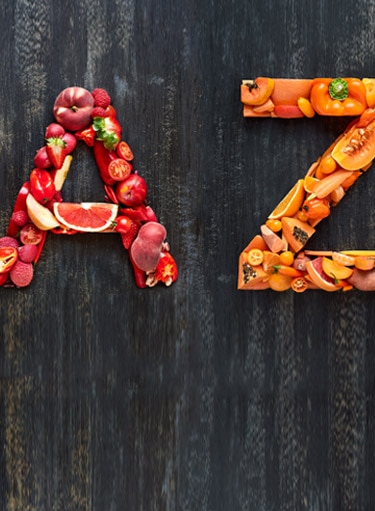- My Ramadan
- Recipes
- Nutrition And Health
-
Brands
- Aero
- COFFEE-MATE®
- CRUNCH® CEREALS
- Cocoa Puffs®
- Fitness Toasties
- illuma 3
- KLIM®
- MAGGI®
- NAN® 3
- NESCAFÉ®
- NESQUIK®
- Nestle® CERELAC®
- Nestle® Pure Life®
- NIDO® PLUS
- PROGRESS KIDS GOLD
- SMARTIES®
- COUNTRY CORN FLAKES®
- CHOCAPIC®
- COOKIE CRISP®
- HONEY CHEERIOS®
- KITKAT®
- LION® CEREAL
- NESCAFÉ® Dolce Gusto®
- NESQUIK® CEREALS
- Nestle® FITNESS®
- NESTLÉ® DESSERT SOLUTIONS
- NIDO® FORTIFIED
- PROMISE PE GOLD
- Perrier®
A-Z to Healthy Living
Nutrition Dictionary
-
Non-haem iron
The iron found in plant foods is known as non-haem iron. Iron from plants is found in wholegrain breads and cereals, legumes, nuts and seeds and some vegetables like spinach. Non-haem iron is not absorbed by the body as well as haem iron from animal products. Eating foods rich in vitamin C with a non-haem iron containing food can help increase absorption of iron by the body.
-
Nutrition
Nutrition is the science of food and its relationship with health. Food is made up of nutrients and a person needs all of the vital nutrients for good health and prevention of disease. These nutrients are proteins, carbohydrates, fat, fiber, vitamins, minerals and water. Good nutrition and a balanced diet are foundations for leading a healthy life.
-
Nestlé Nutrition Compass®
Nestlé Nutrition Compass® is a labelling panel exclusive to Nestlé designed to guide consumers to make healthier choices. It provides nutrition information and tips on how to include the food as part of a balanced diet. It is found on the pack of all Nestlé products.
-
Omega-3
Omega-3 fats are essential polyunsaturated fatty acids. Essential means that they cannot be produced in the body and therefore must be obtained from food. They can be classified into 3 different types: docosahexaenoic acid (DHA), eicosapentaenoic acid (EPA) and alpha-linolenic acid (ALA). EPA and DHA can be used directly by the body’s tissues. ALA can be converted to EPA and DHA in the body, however this is not very efficient, with only 15% of ALA converted to EPA and DHA.
-
Phytoestrogens
Phytoestrogens are naturally occurring plant chemicals that are similar in structure to the human hormone oestrogen. The most common phytoestrogens are the isoflavones found in soy beans and lignans from linseed. Phytoestrogens behave similarly to oestrogen in the body and are thought to help relieve some menopausal symptoms and potentially have other health benefits.
-
Protein
Protein is an essential nutrient that is used in the body for the growth and repair of cells and to provide energy. Protein is found in both plant and animal foods. Sources of protein include meat, eggs, dairy foods, nuts and seeds, dried beans and lentils.
-
Probiotics
Probiotics are bacteria that help replenish the beneficial bacteria in the intestine. Common foods that contain probiotics are yogurt and fortified milk. Maintaining a balance of healthy bacteria in the intestine is beneficial for a healthy digestive system.
-
Polyphenols
Polyphenols are naturally occurring plant chemicals, including flavonoids, catechins, isoflavonoids, lignans and anthocyanins. They are antioxidants that may help protect against oxidative damage and are most commonly found in certain fruits and vegetables, tea, coffee, soy, seeds, lentils and some dark chocolate.
-
Pectin
Pectin occurs naturally in fruit and is often added to foods to thicken or stabilize them. Pectin is also used in throat lozenges because of its soothing properties
-
Phytosterols
Phytosterols are compounds that have a structure like cholesterol and are found naturally in small amounts in foods such as vegetable oils, fruits, legumes and nuts. When consumed regularly in concentrated products such as phytosterol-containing margarines, they can help to lower cholesterol levels by reducing cholesterol absorption.
-
Prebiotic
A prebiotic is a substance that promotes the growth of the beneficial bacteria in the intestine. Prebiotics work by providing food for the intestinal bacteria. Examples of prebiotics are inulin and fructooligosaccharides.
-
Polyunsaturated Fat
Polyunsaturated fats are ‘good fats’. There are two main types of polyunsaturated fats: Omega-3 and Omega-6. Omega-6 fatty acids are found in sunflower oil, certain margarines, nuts (e.g. walnuts), seeds (e.g. sesame, sunflower) and legumes. Omega-3 fatty acids are found in oily fish such as mackerel, sardines, salmon and tuna as well as canola and soybean oil.
-
Saturated Fat
Saturated fat is commonly referred to as ‘bad fat’ because of its impact on blood cholesterol levels. Saturated fats are often solid at room temperature and are the type of fat predominantly found in meat and dairy foods and also in vegetable sources such as palm and coconut oil.
-
Satiety
Satiety is the physiological feeling of satisfaction or fullness after a meal.
-
Sugars
Also known as saccharides, sugars are the smallest form of carbohydrates. When we digest carbohydrate containing foods they are broken down into single sugars for absorption into the blood. Naturally occurring sugars include fructose (mostly found in fruits) and lactose in milk. Glucose is naturally present in certain fruits and honey and sucrose is found in sugar cane and sugar beet. Cakes, biscuits and soft drinks contain added sugars.
-
Stevia
Stevia is a herb that’s 300 times sweeter than sugar. It’s used as a non-caloric food sweetener.
-
Sodium
Sodium is a mineral that is a component of salt. While our body requires certain amount of sodium to maintain proper functioning, too much has been associated with increased blood pressure in some people.
-
Soluble fiber
Soluble fibre is a type of dietary fibre that is thought to help in lowering cholesterol levels. Beta-glucan is a type of soluble fibre found in high amounts in oats and barley. Fruit and vegetables, dried beans and lentils are other sources of soluble fibre.
-
Trans fat
Trans fat occurs naturally in low levels in some animal foods such as dairy products. Commercially baked or fried foods can be a major source of trans fat, depending on the type of fat used in their manufacture. Trans fats are unsaturated fats that have had their structure changed through the process of hydrogenation and like saturated fats are considered a ‘bad’ type of fat as they have been shown to raise blood cholesterol levels.
-
Triglycerides
Triglycerides are the most common form of fat found in the body and are a major source of energy. They come from the food that we eat and can also be made in the body. High levels of triglycerides in the blood increases the risk of heart disease.
-
Vitamin A
Vitamin A is found in animal foods including liver, dairy products, egg yolk and some fatty fish. Orange and yellow coloured fruit and vegetables (e.g. mangoes, carrots) contain carotenoids such as beta-carotene which are converted into vitamin A in the body. Vitamin A plays an important role in vision and growth and beta-carotene acts as an antioxidant to help protect against free radical damage.
-
Vitamin C
Vitamin C plays a role in ensuring healthy connective tissue such as skin and cartilage. Vitamin C is also an antioxidant and can be found in a wide range of fruits and vegetables.
-
Vitamin D
Vitamin D is a fat-soluble vitamin that promotes the absorption of calcium and its deposition in bones and teeth making them stronger and healthier. Adequate vitamin D prevents rickets (weakened bones) in children and osteomalacia in adults, and when combined with enough calcium, helps prevent osteoporosis in older adults. The body can make vitamin D when exposed to sunlight, another guaranteed source is foods fortified with vitamin D such as milk and cereals. Recent studies link vitamin D deficiency with the development of chronic diseases such as cancer and diabetes.
-
Vitamins
Vitamins are essential micronutrients that are used in the body for a variety of processes. They are classified into two groups - fat soluble and water soluble. The fat soluble vitamins are vitamins A, D, E and K. The B group vitamins (B1, B2, B3, B12), folate, biotin and vitamin C are water soluble vitamins.
-
Vitamin E
The main role of Vitamin E in the body is as an antioxidant. Vitamin E protects many substances from oxidation but is particularly important for maintaining the stability of cell membranes by protecting them from free radical damage. Good sources of vitamin E include almonds, peanuts and soy bean oil.
-
Zinc
Zinc is a mineral that plays a part in many functions in the body including wound healing and can be found in oysters, beef and wholegrain breads and cereals.








